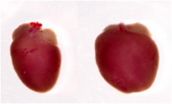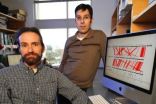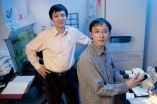(Press-News.org) CHAPEL HILL, N.C. – Everyone knows chocolate is critical to a happy Valentine's Day. Now scientists are one step closer to knowing what makes a heart happy the rest of the year.
It's a gene called DOT1L, and if you don't have enough of the DOT1L enzyme, you could be at risk for some types of heart disease. These findings from a study led by researchers at the University of North Carolina at Chapel Hill School of Medicine appear in the Feb. 1, 2011 issue of the journal Genes and Development.
The team created a special line of mice that were genetically predisposed to dilated cardiomyopathy, a condition in which the heart expands like a balloon, causing its walls to thin and its pumping ability to weaken. About one in three cases of congestive heart failure is due to dilated cardiomyopathy, a condition that also occurs in children.
These mice lack DOT1L. The big discovery came when the researchers were able to prevent the mice from developing the disease by re-expressing a single downstream target gene, Dystrophin.
"We saw this phenotype in the heart and it could be attributed to anywhere between 1 and 1,000 genes. But when we just added back this one gene, the heart function was completely rescued," said the study's lead author, Anh Nguyen, a graduate student in the lab of biochemist Yi Zhang, PhD, at UNC's Lineberger Comprehensive Cancer Center. "It was very surprising to us," Nguyen added. "Normally you'd think you'd have to add in a number of genes to really see that effect."
The researchers discovered that the gene depends on the enzyme DOT1L to activate it. If DOT1L levels fall too low, Dystrophin ceases to perform its function, eventually leading to heart disease.
"We've identified a new function of DOT1L, which has been linked to leukemia before, but never linked to heart defects," said Zhang, Kenan Distinguished Professor of biochemistry and biophysics and an Investigator of the Howard Hughes Medical Institute.
Learning how the DOT1L affects Dystrophin could eventually help to improve diagnosis and treatment of patients with dilated cardiomyopathy and other conditions. "The more we know about the protein, the better we can use it," Zhang said.
The protein could be a target for gene therapy, for example. "If you could manipulate the function of DOT1L, then you could essentially regulate everything else downstream, including Dystrophin or other genes," explained Nguyen.
In addition to their experiments using mice, the team examined samples of human heart tissue. Patients with dilated cardiomyopathy had lower levels of DOT1L than patients with no underlying heart condition, suggesting that the protein's role in humans is similar to its role in mice.
The findings also have potential relevance for Duchenne muscular dystrophy, which is caused by defects in Dystrophin function. About 90% of people with muscular dystrophy develop dilated cardiomyopathy; this study suggests perhaps low levels of DOT1L could be a common factor in both conditions.
INFORMATION:
The study's collaborators include Xiao Xiao, PhD, Fred Eshelman Distinguished Professor of Gene Therapy in the division of molecular pharmaceutics in the UNC School of Pharmacy, Da-Zhi Wang, PhD, of Harvard Medical School, and Taiping Chen, PhD, of Norvartis Institutes for Biomedical Research.
Just in time for Valentine's Day: UNC researchers identify a gene critical for heart function
2011-02-05
ELSE PRESS RELEASES FROM THIS DATE:
First stars in universe were not alone
2011-02-05
The first stars in the universe were not as solitary as previously thought. In fact, they could have formed alongside numerous companions when the gas disks that surrounded them broke up during formation, giving birth to sibling stars in the fragments. These are the findings of studies performed with the aid of computer simulations by researchers at Heidelberg University's Centre for Astronomy together with colleagues at the Max Planck Institute for Astrophysics in Garching and the University of Texas at Austin (USA). The group's findings, published in Science Express, ...
Smithsonian scientists discover 7 new species of fish
2011-02-05
Things are not always what they seem when it comes to fish—something scientists at the Smithsonian Institution and the Ocean Science Foundation are finding out. Using modern genetic analysis, combined with traditional examination of morphology, the scientists discovered that what were once thought to be three species of blenny in the genus Starksia are actually 10 distinct species. The team's findings are published in the scientific journal ZooKeys, Feb. 3.
Starksia blennies, small (less than 2 inches) fish with elongated bodies, generally native to shallow to moderately ...
HPV vaccine works for boys: Study shows first clear benefits
2011-02-05
The vaccine for human papillomavirus (HPV) can prevent 90 percent of genital warts in men when offered before exposure to the four HPV strains covered by the vaccine, according to a new multi-center study led by H. Lee Moffitt Cancer Center and UCSF.
The four-year, international clinical trial, which also found a nearly 66 percent effectiveness in the general population of young men regardless of prior exposure to these strains, provides the first reported results of using the HPV vaccine as a prophylactic in men.
Initial data from this study informed the Food and Drug ...
ParentCorps helps children do better in school
2011-02-05
NEW YORK (February 4, 2011) – Researchers at the NYU Child Study Center demonstrated that a brief program for families of Pre-Kindergarten students attending schools in disadvantaged urban communities improved children's behavior at school. The study, called "Promoting effective parenting practices and preventing child behavior problems in school among ethnically diverse families from underserved, urban communities," was published in the February 2011 issue of Child Development.
Dr. Laurie Miller Brotman and her colleagues spent several years developing ParentCorps, ...
Discovery of jumping gene cluster tangles tree of life
2011-02-05
Since the days of Darwin, the "tree of life" has been the preeminent metaphor for the process of evolution, reflecting the gradual branching and changing of individual species.
The discovery that a large cluster of genes appears to have jumped directly from one species of fungus to another, however, significantly strengthens the argument that a different metaphor, such as a mosaic, may be more appropriate.
"The fungi are telling us something important about evolution … something we didn't know," said Antonis Rokas, assistant professor of biological sciences at Vanderbilt. ...
Johns Hopkins researchers capture jumping genes
2011-02-05
An ambitious hunt by Johns Hopkins scientists for actively "jumping genes" in humans has yielded compelling new evidence that the genome, anything but static, contains numerous pesky mobile elements that may help to explain why people have such a variety of physical traits and disease risks.
Using bioinformatics to compare the standard assembly of genetic elements as outlined in the reference human genome to raw whole-genome data from 310 individuals recently made available by the 1000 Genomes Project, the team revealed 1,016 new insertions of RIPs, or retrotransposon ...
A loose grip provides better chemotherapy
2011-02-05
Researchers at Case Western Reserve University have developed a little bomb that promises a big bang for cancer patients.
Preliminary tests show an anti-cancer drug loosely attached to gold nanoparticles starts accumulating deep inside tumors within minutes of injection and can be activated for an effective treatment within two hours. The same drug injected alone takes two days to gather and attacks the tumor from the surface – a far less effective route.
The work, titled "Deep Penetration of a PDT Drug into Tumors by Noncovalent Drug-Gold Nanoparticle Conjugates," ...
The brain knows what the nose smells, but how? Stanford researchers trace the answer
2011-02-05
Mice know fear. And they know to fear the scent of a predator. But how do their brains quickly figure out with a sniff that a cat is nearby?
It's a complex process that starts with the scent being picked up by specific receptors in their noses. But until now it wasn't clear exactly how these scent signals proceeded from nose to noggin for neural processing.
In a study to be published in Nature (available online now to subscribers), Stanford researchers describe a new technique that makes it possible to map long-distance nerve connections in the brain. The scientists ...
Peripheral artery disease harder on women
2011-02-05
CHICAGO --- Small calf muscles may be a feminine trait, but for women with peripheral artery disease (PAD) they're a major disadvantage. Researchers at Northwestern Medicine point to the smaller calf muscles of women as a gender difference that may cause women with PAD to experience problems walking and climbing stairs sooner and faster than men with the disease.
The study was published in the February 2011 issue of the Journal of the American College of Cardiology.
Peripheral artery disease affects eight million men and women in the United States. The disease causes ...
MyBinding.com Promotes Shawn Slotkin to Inside Sales Manager
2011-02-05
MyBinding,com, a division of Information Management Services, LCC, announces the promotion of Shawn Slotkin from Account Executive to Inside Sales Supervisor
MyBinding.com, one of the country's leading online retailers of document finishing equipment and supplies, recently announced that one of their account executives, Shawn Slotkin, has been promoted. Slotkin is now serving as Inside Sales Supervisor. His promotion was announced in a company e-mail on Friday, January 28, 2011.
"I'm excited," said Slotkin. "I've been waiting for this opportunity for quite a while." ...



